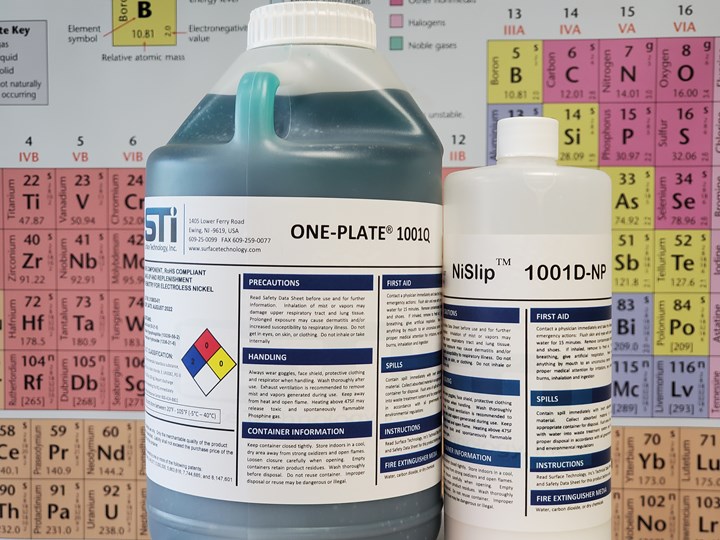Making EN-PTFE Plating Cheaper, Easier, and More Environmentally Friendly
New Electroless Nickel – PTFE system offers multiple benefits and builds upon single component EN plating concept.

Surface Technology Inc.’s One-Plate Electroless Nickel – Teflon system
Innovations are valuable if they provide just one benefit. Surface Technology, Inc. (STI, Ewing, N.J.) has developed an innovative electroless nickel PTFE plating process with multiple benefits. It has cost, performance, and environmental benefits — and it builds on the recent invention of the company's One-Plate electroless nickel where just one component is needed for both make up and replenishment of the plating bath.
Historically, electroless nickel baths including those used for EN-PTFE have been made with about 20% by volume total of two components, A and B. The traditional concentration of nickel in the bath has been 6 grams per liter. A One-Plate bath is made up with just 15% by volume of just one component called “Q” (which STI named after the famous inventor in James Bond movies.) At this 15% make up, the bath has 5 grams per liter of nickel (18% less than a traditional 6 gram per liter bath). This difference makes the One-Plate cheaper to make up, reduces the amount of nickel dragged out during use, and reduces the amount of nickel wasted at the end of the bath life.
To do EN-PTFE plating, shops simply add one of STI's PTFE dispersions to a One-Plate bath. But the difference that has earned our Innovator recognition this month is that it can be done with a bath that is just a 10% make up instead of 15%, 20% or more. At a 10% make up, the bath has only 3.3 grams per liter of nickel. This approach cuts essentially in half the cost to make up the bath, the amount of drag out, and waste.
The concept of operating electroless nickel at a low metal concentration is not a new idea. A previously published article from the April 2014 issue of Products Finishing explains the concept: short.pfonline.com/sti1plate
Despite the numerous potential benefits of running at a low metal concentration, the practice has not achieved widespread popularity. The main reason reported by shops is that more frequent replenishment of the bath becomes critical to keep the metal concentration from going even lower. If the concentration of nickel and other ingredients gets too low, plating quality will suffer and the bath may become unstable. EN baths have historically been replenished with two components, A and C.
So why would a low metal concentration work with the One-Plate PTFE bath? STI president Michael Feldstein explains, “There are two main reasons: First, all EN-PTFE baths inherently plate more slowly than other EN baths. Second, replenishing with just one component makes it faster and easier.”
Together these points make the low metal system practical and advantageous. The slower plating rate means that the operator does not need to excessively monitor the concentration of the bath, and when replenishment is necessary it is much quicker with just the addition of one component instead of the traditional two A and C components. In addition, the simplicity of a single component means that a shop can use the option of a small pump to continually replenish the bath and avoid manual replenishment altogether. This option will also keep the bath at optimal concentration and performance.
This innovation provides the benefits of low metal operation on top of the other features of the One-Plate system that are important for EN-PTFE plating systems such as: medium and high phosphorous products, long bath life, RoHS compliance, no PFOA, no PFOS, and coatings up to 30% PTFE with the distinctive color of EN-PTFE.
Learn more: Read more about how second level innovation such as a practical way to do "bleed and feed" EN plating, and now low metal operation, can be built on a primary innovation like the single component EN system of STI's One-Plate: short.pfonline.com/OnePlate.
Related Content
Successful South African Plater Beating the Odds
Remaining focused on quality and reliability, Team Plating Works stays profitable in a volatile and challenging economy.
Read MorePossibilities From Electroplating 3D Printed Plastic Parts
Adding layers of nickel or copper to 3D printed polymer can impart desired properties such as electrical conductivity, EMI shielding, abrasion resistance and improved strength — approaching and even exceeding 3D printed metal, according to RePliForm.
Read MoreA Chromium Plating Overview
An overview of decorative and hard chromium electroplating processes.
Read MoreTrivalent Chrome Overview
As the finishing industry begins to move away from the use of hexavalent chromium to trivalent chromium, what factors should finishers consider as they make new investments? Mark Schario, chief technology officer for Columbia Chemical offers a helpful overview of this complicated topic.
Read MoreRead Next
Education Bringing Cleaning to Machining
Debuting new speakers and cleaning technology content during this half-day workshop co-located with IMTS 2024.
Read MoreDelivering Increased Benefits to Greenhouse Films
Baystar's Borstar technology is helping customers deliver better, more reliable production methods to greenhouse agriculture.
Read MoreA ‘Clean’ Agenda Offers Unique Presentations in Chicago
The 2024 Parts Cleaning Conference, co-located with the International Manufacturing Technology Show, includes presentations by several speakers who are new to the conference and topics that have not been covered in past editions of this event.
Read More










.jpg;maxWidth=300;quality=90)








